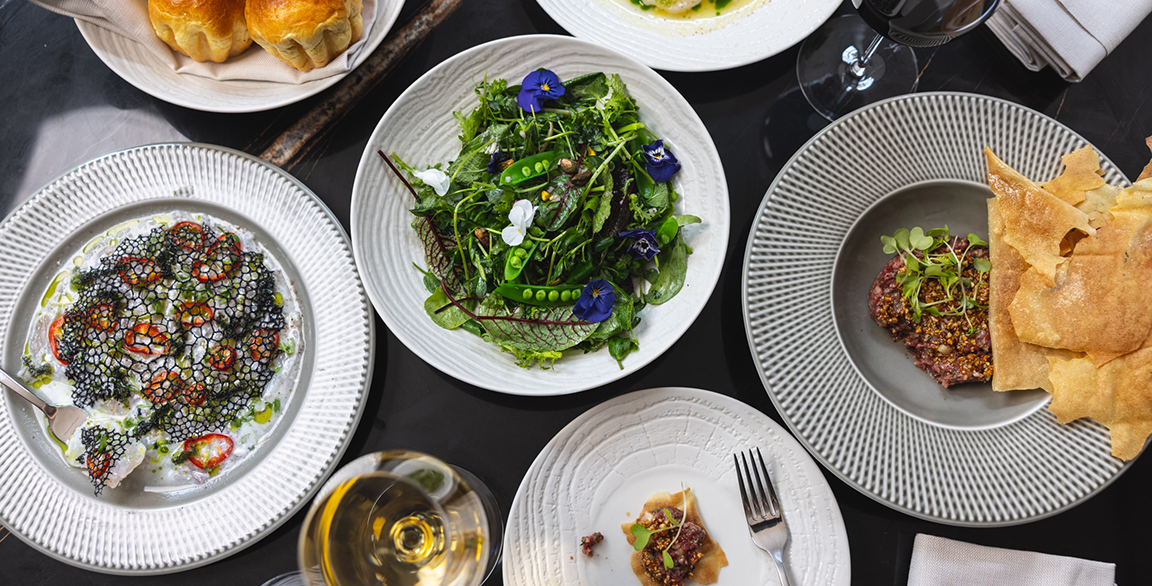
How Supporting Players Become Menu Superstars
A case study in how high-impact ingredients can transform any dish
How Supporting Players Become Menu Superstars
A case study in how high-impact ingredients can transform any dish
By Nicole Duncan
January 16, 2024
By Nicole Duncan
January 16, 2024
When making a dish shine in a new light, seemingly minor players can elevate a familiar item into a headliner. Justine’s on Hudson, which opened last spring in New York, offers a case study in reimagining the menu through powerhouse ingredients, from delicate microgreens and edible flowers to crunchy toppers and creative accents. The restaurant is rooted in French cuisine, but global flourishes abound, transforming dishes as traditional as a beef tartare into fresh finds.
“You can always copy a recipe, but that will never be your recipe. You can get inspired, but you have to make it your own and be creative,” says Justine’s chef, Jeanne Jordan. “I can make a polenta dish with mushrooms, but it will just be a polenta with mushrooms.” The challenge lies in making such a dish stand apart from other renditions.
Simplicity is key. The assumption may be that high-impact ingredients are reserved for elaborate dishes with dozens of ingredients, but that’s hardly the case. If anything, using fewer components allows each to stand out. That’s why Jordan will never use more than a handful of ingredients in a single dish. “We have five elements in each dish. One is the main and everything else is a supporting role,” she says. “The process is trying to accentuate what the main ingredient is through other ingredients.”
And in terms of menu innovation, these supporting players have more latitude because they needn’t anchor the dish. Instead, their power-play role is to impart a new dimension of flavor, texture and visual appeal, with the goal of leaving a lasting impact.
For inspiration, Jordan looks to her culinary education—both at school and on the line—as well as her own Filipino-American heritage. She also leans on her kitchen staff for new ideas. In fact, her staff, many of whom are of Guatemalan descent, are currently developing a tamale dish, which Jordan expects to differ from her idea of a Filipino tamale.
The menu at Justine’s changes regularly—sometimes twice in a single day—meaning it’s a constant hub of innovation. The following five examples demonstrate how chefs can enhance their dishes through the addition of impactful supporting ingredients.
1
Artistic Expression
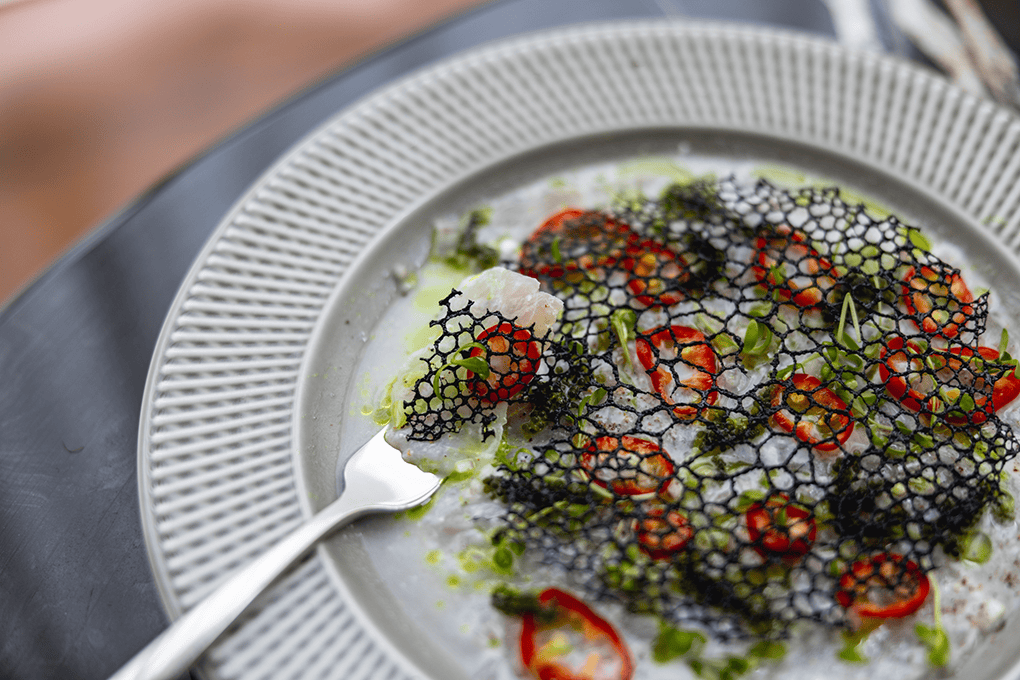 Photo Credit: Dillon Burke
Photo Credit: Dillon Burke The produce in the Sea Bass Carpaccio rotates with the seasons, with this version using a seaweed varietal, coconut and chiles. What remains constant is the visually stunning pistachio praline topper.
In Justine’s seafood-centric carpaccio, sea bass is complemented by crispy produce that changes with the seasons (currently jicama and mutsu apples). “It’s great to taste the raw state of whatever it is that we have at hand,” Jordan says. Rather than lemon, she brightens the dish with calamansi, a staple citrus in the Philippines, as well as mint, basil and parsley.
But the visual pièce de résistance is the eye-catching latticework of pistachio praline, which mellows the citrus and brings a little richness from the pistachio. “The sweetness balances the acidity of the calamansi, and the nuttiness makes the jicama stand out,” Jordan says.
2
From Humble to Highlight
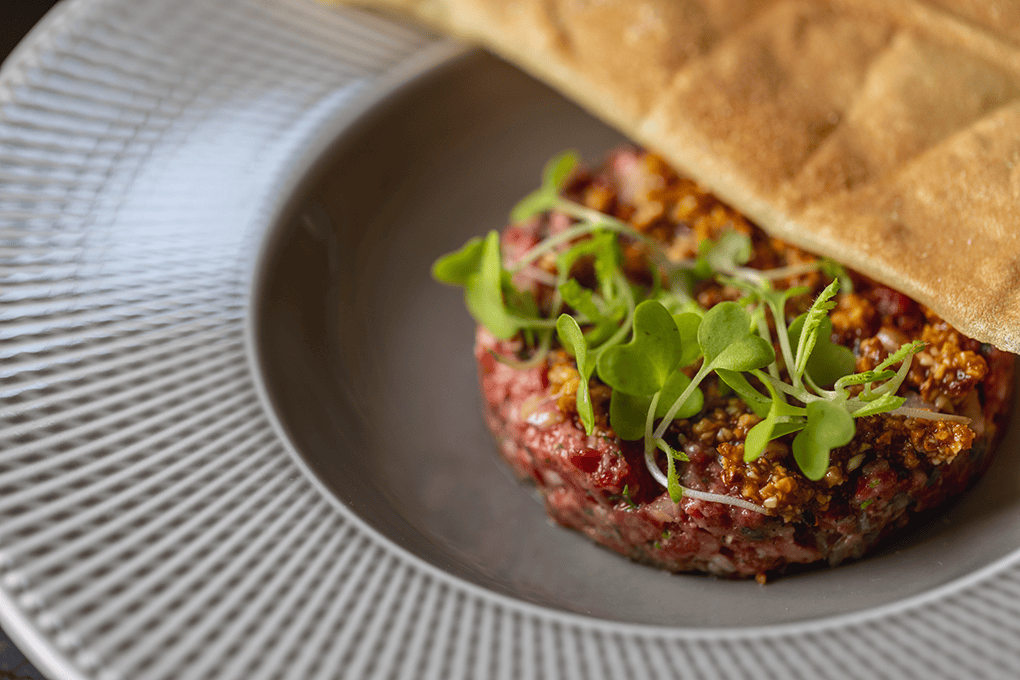 Photo Credit: Dillon Burke
Photo Credit: Dillon Burke Blending peanuts and herbs into a gremolata lightens the beef tartare. The dish gets a sprinkle of microgreens for a burst of freshness.
Jordan’s take on beef tartare demonstrates how an ingredient as humble as peanuts can enhance a high-caliber protein. At the center of the dish is the lesser-known cut, zabuton, which means “little pillow” in Japanese. Cut from the chuck area, specifically the shoulder blade, zabuton is well-marbled with a melt-in-the-mouth texture. “The meat almost has a nuttiness to it because of the fat,” Jordan says.
To add textural contrast to butter-like tartare, Jordan turns to peanuts, which are ubiquitous in Filipino cuisine. She grinds them into a gremolata, along with parsley, garlic and citrus. The peanuts enhance the zabuton’s nutty notes and the herbs impart Mediterranean flavor. A topper of microgreens and carta di musica (Sardinian crackers) provide an airy finish and fresh color.
3
A Pop of Purple
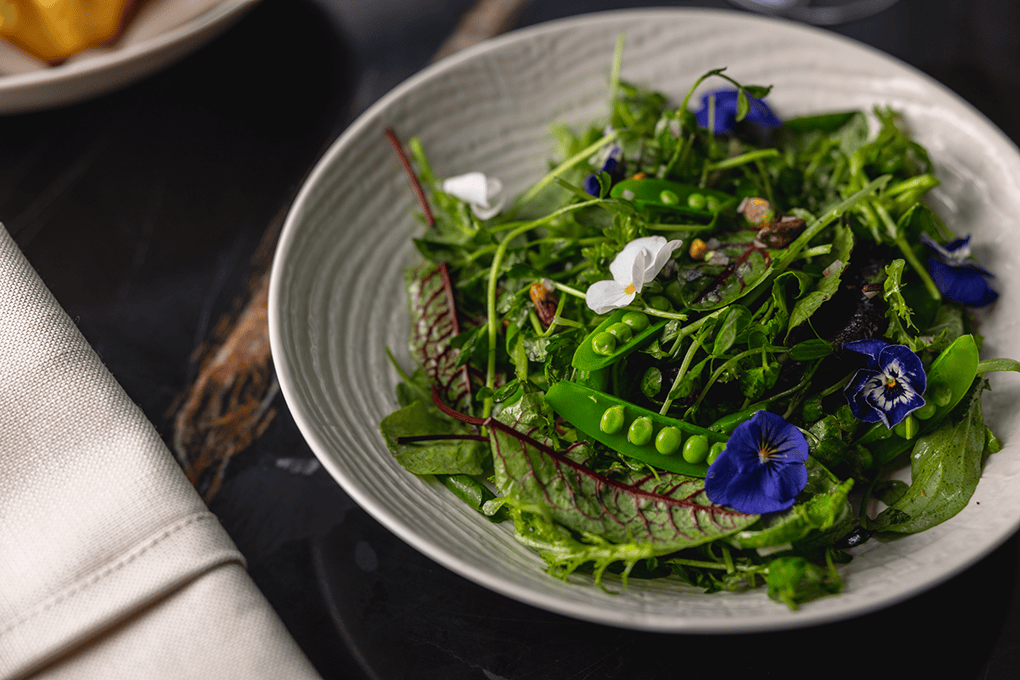 Photo Credit: Dillon Burke
Photo Credit: Dillon Burke Edible viola flowers provide a rich color contrast in Justine’s Garden Salad.
True to its name, Justine’s Garden Salad features a farm-fresh medley of mixed greens, herbs, snap peas, dates and pistachios. While housemade lemon vinaigrette adds a bit of citrusy sweetness, it’s the array of viola blossoms that ties the dish together. These edible flowers are mild in flavor but provide colorful pops of deep purple and white in an otherwise all-green presentation.
4
Savory Textures
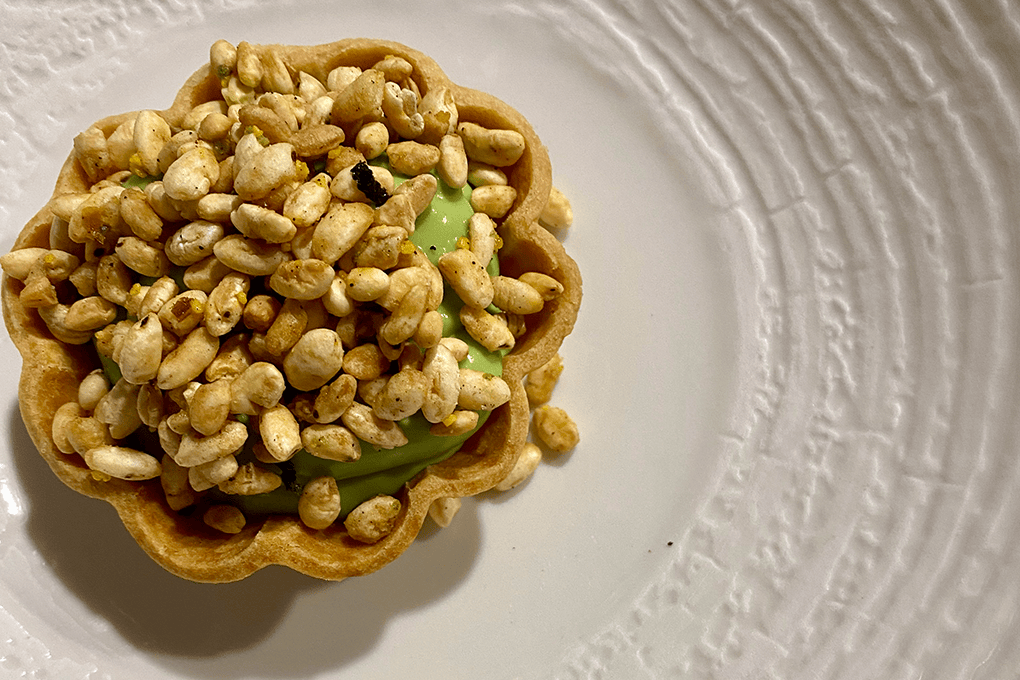 Photo Credit: Justine’s on Hudson
Photo Credit: Justine’s on Hudson Hawaiian furikake chips, which are especially popular in Japan, bring a salty crunch to the Matcha Chocolate Cremeaux.
Justine’s now has a dedicated dessert chef, but when the restaurant first opened, Jordan was tasked with developing both the savory and sweet dishes. She turned to cremeaux, which in addition to being a crowd-pleaser, is easy to prepare. The original featured 74 percent chocolate, but an updated version adds matcha into the mix, thus enhancing the bittersweetness and bringing earthier notes into play.
Served in a tart shell, the dessert is topped with furikake crisps for an extra crunch and a bit of savory saltiness. “The salinity from the furikake is really nice. It’s almost like adding sea salt,” she says.
5
Purposeful Shavings
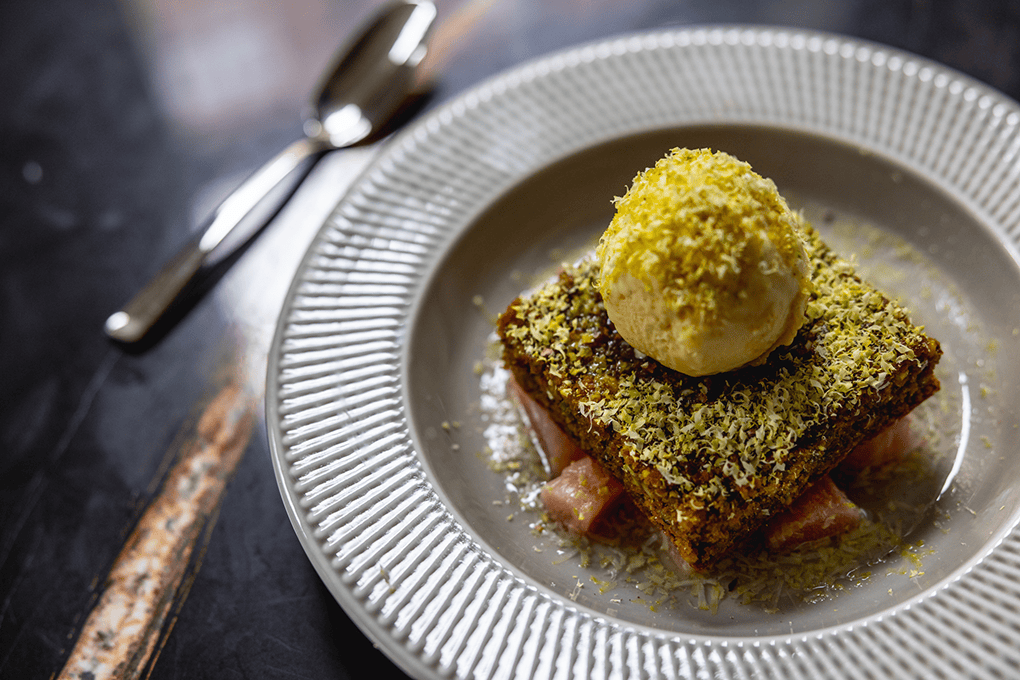 Photo Credit: Dillon Burke
Photo Credit: Dillon Burke Shaved pistachio adds a delicate but striking balance to this dessert, which features pistachio cake, rhubarb and salted egg yolk ice cream.
Although the pistachio cake at Justine’s sticks to Jordan’s rule of five or fewer ingredients, three of them could be standalones in their own right. Roasted rhubarb serves as a tart base, upon which the pistachio cake rests, and a scoop of salted egg yolk ice cream is perched atop.
With a trio of strong flavors, a simple topper of shaved pistachios leaves a lasting impact, reinforcing the cake’s nutty notes while lending a textured mouthfeel to the overall dish.
When making a dish shine in a new light, seemingly minor players can elevate a familiar item into a headliner. Justine’s on Hudson, which opened last spring in New York, offers a case study in reimagining the menu through powerhouse ingredients, from delicate microgreens and edible flowers to crunchy toppers and creative accents. The restaurant is rooted in French cuisine, but global flourishes abound, transforming dishes as traditional as a beef tartare into fresh finds.
“You can always copy a recipe, but that will never be your recipe. You can get inspired, but you have to make it your own and be creative,” says Justine’s chef, Jeanne Jordan. “I can make a polenta dish with mushrooms, but it will just be a polenta with mushrooms.” The challenge lies in making such a dish stand apart from other renditions.
Simplicity is key. The assumption may be that high-impact ingredients are reserved for elaborate dishes with dozens of ingredients, but that’s hardly the case. If anything, using fewer components allows each to stand out. That’s why Jordan will never use more than a handful of ingredients in a single dish. “We have five elements in each dish. One is the main and everything else is a supporting role,” she says. “The process is trying to accentuate what the main ingredient is through other ingredients.”
And in terms of menu innovation, these supporting players have more latitude because they needn’t anchor the dish. Instead, their power-play role is to impart a new dimension of flavor, texture and visual appeal, with the goal of leaving a lasting impact.
For inspiration, Jordan looks to her culinary education—both at school and on the line—as well as her own Filipino-American heritage. She also leans on her kitchen staff for new ideas. In fact, her staff, many of whom are of Guatemalan descent, are currently developing a tamale dish, which Jordan expects to differ from her idea of a Filipino tamale.
The menu at Justine’s changes regularly—sometimes twice in a single day—meaning it’s a constant hub of innovation. The following five examples demonstrate how chefs can enhance their dishes through the addition of impactful supporting ingredients.
1
Artistic Expression
 Photo Credit: Dillon Burke
Photo Credit: Dillon Burke The produce in the Sea Bass Carpaccio rotates with the seasons, with this version using a seaweed varietal, coconut and chiles. What remains constant is the visually stunning pistachio praline topper.
In Justine’s seafood-centric carpaccio, sea bass is complemented by crispy produce that changes with the seasons (currently jicama and mutsu apples). “It’s great to taste the raw state of whatever it is that we have at hand,” Jordan says. Rather than lemon, she brightens the dish with calamansi, a staple citrus in the Philippines, as well as mint, basil and parsley.
But the visual pièce de résistance is the eye-catching latticework of pistachio praline, which mellows the citrus and brings a little richness from the pistachio. “The sweetness balances the acidity of the calamansi, and the nuttiness makes the jicama stand out,” Jordan says.
2
From Humble to Highlight
 Photo Credit: Dillon Burke
Photo Credit: Dillon Burke Blending peanuts and herbs into a gremolata lightens the beef tartare. The dish gets a sprinkle of microgreens for a burst of freshness.
Jordan’s take on beef tartare demonstrates how an ingredient as humble as peanuts can enhance a high-caliber protein. At the center of the dish is the lesser-known cut, zabuton, which means “little pillow” in Japanese. Cut from the chuck area, specifically the shoulder blade, zabuton is well-marbled with a melt-in-the-mouth texture. “The meat almost has a nuttiness to it because of the fat,” Jordan says.
To add textural contrast to butter-like tartare, Jordan turns to peanuts, which are ubiquitous in Filipino cuisine. She grinds them into a gremolata, along with parsley, garlic and citrus. The peanuts enhance the zabuton’s nutty notes and the herbs impart Mediterranean flavor. A topper of microgreens and carta di musica (Sardinian crackers) provide an airy finish and fresh color.
3
A Pop of Purple
 Photo Credit: Dillon Burke
Photo Credit: Dillon Burke Edible viola flowers provide a rich color contrast in Justine’s Garden Salad.
True to its name, Justine’s Garden Salad features a farm-fresh medley of mixed greens, herbs, snap peas, dates and pistachios. While housemade lemon vinaigrette adds a bit of citrusy sweetness, it’s the array of viola blossoms that ties the dish together. These edible flowers are mild in flavor but provide colorful pops of deep purple and white in an otherwise all-green presentation.
4
Savory Textures
 Photo Credit: Justine’s on Hudson
Photo Credit: Justine’s on Hudson Hawaiian furikake chips, which are especially popular in Japan, bring a salty crunch to the Matcha Chocolate Cremeaux.
Justine’s now has a dedicated dessert chef, but when the restaurant first opened, Jordan was tasked with developing both the savory and sweet dishes. She turned to cremeaux, which in addition to being a crowd-pleaser, is easy to prepare. The original featured 74 percent chocolate, but an updated version adds matcha into the mix, thus enhancing the bittersweetness and bringing earthier notes into play.
Served in a tart shell, the dessert is topped with furikake crisps for an extra crunch and a bit of savory saltiness. “The salinity from the furikake is really nice. It’s almost like adding sea salt,” she says.
5
Purposeful Shavings
 Photo Credit: Dillon Burke
Photo Credit: Dillon Burke Shaved pistachio adds a delicate but striking balance to this dessert, which features pistachio cake, rhubarb and salted egg yolk ice cream.
Although the pistachio cake at Justine’s sticks to Jordan’s rule of five or fewer ingredients, three of them could be standalones in their own right. Roasted rhubarb serves as a tart base, upon which the pistachio cake rests, and a scoop of salted egg yolk ice cream is perched atop.
With a trio of strong flavors, a simple topper of shaved pistachios leaves a lasting impact, reinforcing the cake’s nutty notes while lending a textured mouthfeel to the overall dish.
About the Author
![]() Nicole Duncan is the digital managing editor of Flavor & the Menu. She's reported on the restaurant industry for a decade, most recently as the editor of FSR magazine. In 2021, she won a Folio award for her feature on restaurant tycoon Tilman Ferttita. The following year, FSR was awarded Best Overall Issue for its May 2022 issue featuring Andrew Zimmern. She has profiled well-known chefs including Paola Velez, Fabio Viviani and Daniel Boulud, but also relishes the opportunity to spotlight under-the-radar trends and innovators.
Nicole Duncan is the digital managing editor of Flavor & the Menu. She's reported on the restaurant industry for a decade, most recently as the editor of FSR magazine. In 2021, she won a Folio award for her feature on restaurant tycoon Tilman Ferttita. The following year, FSR was awarded Best Overall Issue for its May 2022 issue featuring Andrew Zimmern. She has profiled well-known chefs including Paola Velez, Fabio Viviani and Daniel Boulud, but also relishes the opportunity to spotlight under-the-radar trends and innovators.








